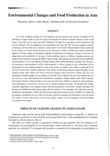Environmental Changes and Food Production in Asia
JIRCAS international symposium series
| ISSN | 13406108 |
|---|---|
| 書誌レコードID(総合目録DB) | AA1100908X |

本文フルテキスト
intlsymp-12_55-62.pdf1.63 MB
As a result of climate change, the air temperature and precipitation may become unsuitable for the cultivation of major cereals in Asia. This paper will describe the impacts of climate change on major cereal crops in Asia such as rice, wheat and maize. Moreover, the impacts of agriculture on the environment will also be presented. The air temperature and precipitation data from the 1961-90 mean monthly terrestrial climatology and the results from simulation studies based on the Global Climate Model (GCM) constructed by the Center for Climate System Research at the University of Tokyo (CCSR) were used to predict the impacts of climate change on sustainable cropping and agricultural development. Changes in the mean air temperature and precipitation in the major cereal-producing regions in different cropping seasons were predicted from the present through the 2090s. Climate change will generally increase both the air temperature and precipitation in Asia. The impacts of climate change could be either beneficial or harmful. The increase in air temperature and precipitation will be disadvantageous to wheat cropping in Asia, while those will be advantageous to rice-cropping during the cooler or dry season. In contrast, some regions in subtropical Asia will have excess water resources during the rainy season. Precautionary measures against flooding will be needed in these areas. Major river basins with rice-cropping zones from East to South Asia were also investigated. Possible changes in water quality in the future were evaluated. The data used included those on the course of a river, land-use/land-cover classification, population, climate, nitrous oxide (NOX) emission, and country boundary. Statistical data on rice yield, harvested area, fertilizer consumption, food production, food consumption and food trade were also used to construct nitrogen load maps. The nitrogen load changes seasonally depending on the cropping systems used and precipitation. In the future, nitrogen discharge from humans and fertilization will increase along with the increase in the population and cultivation intensity. Fertilization and deposition of NOX will also increase along with economic growth. Therefore, it is likely that the nitrogen concentration in river water will increase. Excessive irrigation and fertilization in the dry season will result in further deterioration of the water quality, leading to the development of nonsustainable ecosystems in river basins.
| 作成者 | Katsuo Okammoto Junko Shindo Hideshige Toda Hiroyuki Kawashima |
|---|---|
| 公開者 | Japan International Research Center for Agricultural Sciences |
| オンライン掲載日 | |
| 号 | 12 |
| 開始ページ | 55 |
| 終了ページ | 62 |
| 言語 | eng |
